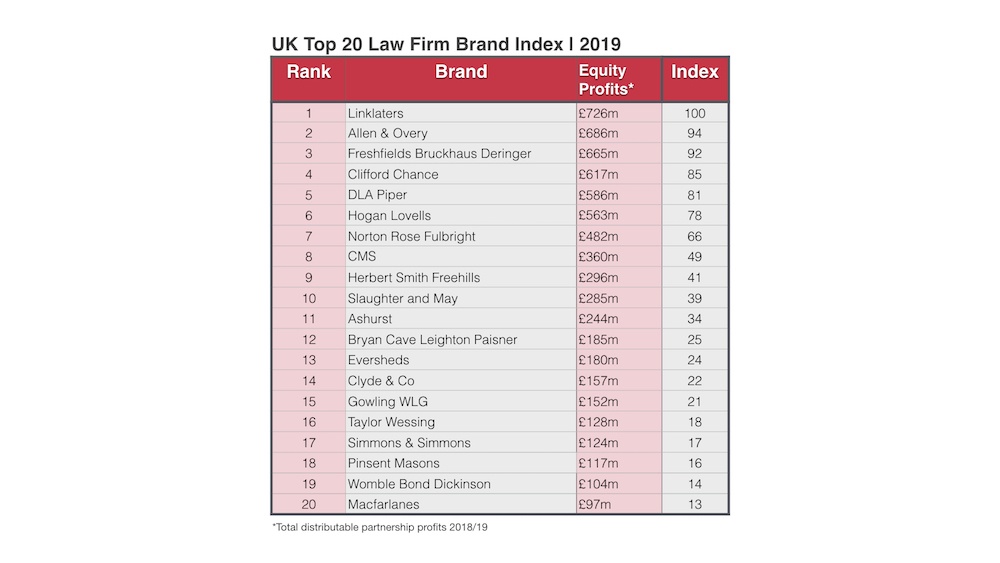UK Top 20 Law Firm Brand Index | 2019
Following up on our recent US Top 50 and Global Top 50 Law Firm Brand Indexes, this month, we’ve analysed and ranked the Top 20 UK Law Firm Brands in our 2019 Index.
Key points
- Linklaters retains its lead at no.1, making it the most valuable UK law firm brand.
- The Magic Circle firms continue to dominate the rankings but are slowly being caught up.
- The traditional UK Silver Circle firms holding their rankings and have posted greater increases in brand strength than Magic Circle firms over the last two years.
- Two firms (Bryan Cave Leighton Paisner and Womble Bond Dickinson) buoyed by recent mergers enter the UK top 20 for the first time.
- Three verein-structured firms DLA Piper, Norton Rose and CMS, added the most value to their brands over the last two year period.
- Aside from the mergers, Eversheds and Ashurst are leading with growth in relative brand strength.
- Group of ‘super-national’ UK firms (including Eversheds and Clyde & Co) pulling away from a large following pack of mid-sized international firms.

As with previous indexes, Principia’s brand value ranking methodology is based on a measure of each equity partnership’s total distributable profits (see ‘economics sidebar’ below for rationale and details) giving an entirely objective measure of brand strength. One that also tends to correlate intuitively with perceived pecking order by market participants and observers (i.e. clients and partners within the leading firms).
Still performing tricks
Linklaters retains its lead as the most valuable UK law firm brand this year but is also still closely matched in brand strength by the other members of the Magic Circle (Allen & Overy, Freshfields and Clifford Chance) who continue to move forward together on a global stage like synchronised swimmers, despite not particularly trying to.
The leading US firms are accelerating away from the rest of the US pack — the opposite of the UK situation.
Despite their dominance, however, two observations might indicate a need to rethink their brand strategies going forward. The least urgent of the two is that the data shows the pack of firms chasing the Magic Circle are all growing their brand strength at a faster rate (i.e. they are behind but are gaining ground on them). The more significant concern, only visible by comparison with the leading US-headquartered firms, is that the Magic Circle firms are in the doldrums in terms of the growth in the value of their brands on a global stage (see US Top 50 US Law Firm Brand Index). The leading US firms are accelerating away from the rest of the US pack — the opposite of the UK situation.
Strategically this is in part due to the recent buoyancy of the US domestic market. Still, while this might explain the overall growth among the US Top 50, it doesn’t explain why firms like Kirkland, Latham and Skadden are accelerating away from the other US firms. Comparing just two firms to illustrate the difference, whereas Linklaters increased their partnership profitability by £37m over the last two years, Kirkland increased theirs by £540m!
Nonetheless, it’s hard to be too critical; these firms continue to dominate a highly competitive field.
Trading up
The following pack of firms has been slowly reordered over the last decade with three big ‘verein’ structured firms joining the top 10 — DLA Piper, Norton Rose Fulbright and CMS. Sceptics often said that while these firms could quickly grow in size, they wouldn’t be able to translate that into a reputation for high-quality / high-premium work to compete with the traditional partnership structures.
This analysis shows that while that might have been the case some years ago, these firms are now beginning to leverage their geographical expansion and global platforms much more effectively, creating highly valuable brands. Aside from firms boosted by mergers (see later) these three firms also added the most absolute value to their brands over the last two years.
Silver service
The traditional Silver Circle firms (Hogan Lovells, Herbert Smith and Ashurst in particular) are holding their own in the rankings and delivering healthy increases in overall brand strength and profitability. Mainly by continuing to translate their platforms into more effective propositions for clients and some degree of specialisation and market segment focus. Ashurst, in particular, has put in one of the best performances over the last two years, increasing the value and strength of its brand by 33%.
New faces
Two new firms have entered the UK top 20 this year — both boosted by mergers that have given them significantly increased geographical reach — Bryan Cave Leighton Paisner (BCLP) and Womble Bond Dickenson. BCLP, in particular, wins the prize for gaining the most top 20 places — with an increase of 9 — as well as the greatest increase in brand strength — increasing its value by 73%.
Whether the heritage-UK firms will continue to grow and be significant players on a global stage remains to be seen.
UK to the world
These newly merged firms join a group of super-national firms (that needs a moniker) that make up the rest of the UK top 20 that includes Eversheds, Clyde & Co, Gowling WLG, Taylor Wessing, Simmons & Simmons and Pinsent Masons. Firms with many international offices and an increasingly global reach.
These firms used to be part of a much broader collection of ‘UK firms with international networks’ but have recently managed to put some clear blue water between themselves and the rest of the pack in terms of their brand strength and value. Other large-scale future mergers may yet add to this group — particularly if smaller UK firms can find a strong US partner firm to combine with.
Changing world
A final note to say that whilst the delineation between ‘US-headquatered’ and ‘UK-headquatered’ law firms made perfect sense 10+ years ago, it’s clear that as globalisation finally penetrates the legal market this difference will become increasingly irrelevant — see An American Law Firm in London — and the UK market will be soon no longer be the captive market for UK law firms that it once was. Whether the heritage-UK firms will continue to grow and be significant players on a global stage remains to be seen.
Whereas once the most prominent global law firm brands were also the most significant UK (and even London) brands, that is increasingly not the case. Future success for the most valuable UK law firm brands today (i.e. the Magic Circle) depends on finding a way to gain significant brand traction in the US market, which still represents close to 50% of the entire global market in terms of premium work and perhaps even more in terms of the source of the most significant global mandates.
—
Economics sidebar – why total partnership profits are an accurate measure of relative brand strength in Big Law.
The key to this insight lies in the underlying dynamics of the law firm market which although quirky in many ways is, in economic-theory terms, a reasonably frictionless or ‘pure’ market (lots of competitors with relatively low market share, low barriers to entry/exit, similar products and excellent price visibility).
In other sectors profits can be heavily influenced by ownership of critical IP (pharma), regulations and licences that thwart competition (telecoms), assets that bar entry (energy), effective monopolies or oligopolies (big tech), etc. none of which applies in any significant way in the premium legal market.
Firms only succeed commercially over time if they compete effectively year in year out for what they earn and because the purchase cycle is relatively short clients can react quickly to any perceived changes in the relative competitiveness of any one firm.
Being a relatively ‘pure’ market, individual firms (and their partners) compete based on 3 components: reputation (what those who’ve experienced you think about your service), relevance (what problems you’re perceived to be best at solving and where geographically you solve them) and visibility (how well known you’re known to the clients around the world who have those problems – and the budgets to pay for your services).
These three components added together comprise a firm’s ‘brand’ – the combined brand equity of the firm and the partners within it (who also have brands of their own) – arguably the only source of sustainable competitive advantage that a law firm has.
It’s useful to point out that being a ‘stronger’ and more valuable brand overall does not necessarily imply being a ‘better’ brand for every occasion. For instance, the Mercedes brand is regularly measured to be approx. ten times as valuable as the Ferrari brand in surveys ($50bn vs $5bn).
End


